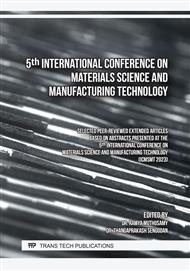[1]
N. Soltani et al., Review on the physicochemical treatments of rice husk for production of advanced materials, Chemical Engineering Journal. 264(2015) 899-935.
DOI: 10.1016/j.cej.2014.11.056
Google Scholar
[2]
Agricultural Statistics at a Glance 2021, Government of India Ministry of Agriculture & Farmers Welfare Department of Agriculture & Farmers Welfare Directorate of Economics & Statistics, New Delhi, India, 2021, pp.48-50.
DOI: 10.32381/prod.2019.59.04.8
Google Scholar
[3]
M.K. Shwetha, H.M. Geethanjali and K. Chowdary, A great opportunity in prospective management of rice husk, International Journal of Commerce and Business Management. 7(1) (2014) 176-180.
Google Scholar
[4]
R. Pode, Potential applications of rice husk ash waste from rice husk biomass power plant, Renewable and Sustainable Energy Reviews. 53(2016) 1468-1485.
DOI: 10.1016/j.rser.2015.09.051
Google Scholar
[5]
K. R. Joseph et al., A review on sisal fiber reinforced polymer composites, Revista Brasileira de Engenharia Agricola Ambiental. 3 (3) (1999) 367–379.
DOI: 10.1590/1807-1929/agriambi.v3n3p367-379
Google Scholar
[6]
M. Sarang, S. Bhattacharyya and R. C. Behera, Rice effect of temperature on morphology and phase transformations of nanocrystalline silica obtained from rice husk, Phase transitions: a multinational journal. 82(5) (2009) 377 -386.
DOI: 10.1080/01411590902978502
Google Scholar
[7]
A.S. Muntohar, Utilization of uncontrolled burnt rice husk ash in soil improvement, Dimensi Teknik Sipil. 4(2) (2002) 100-105.
Google Scholar
[8]
B.M. Ugheoke, et al., Property optimization of Kaolin - rice husk insulating fire bricks, Journal of Practices and Technologies. 9(2006) 167-178.
Google Scholar
[9]
S. Fernando et al., Engineering properties of waste-based alkali activated concrete brick containing low calcium fly ash and rice husk ash: A comparison with traditional Portland cement concrete brick, Journal of Building Engineering. 46 (2022) 103810.
DOI: 10.1016/j.jobe.2021.103810
Google Scholar
[10]
M. Asadullah, Role of microporosity and surface functionality of activated carbon in methylene blue dye removal from water, Korean J. Chem. Eng. 30 (2013) 2228–2234.
DOI: 10.1007/s11814-013-0172-y
Google Scholar
[11]
T. Wang et al., Facile preparation and sulfidation analysis for activated multiporous carbon@NiCo2S4 nanostructure with enhanced supercapacitive properties, Electrochim. Acta. 211 (2016) 627–635.
DOI: 10.1016/j.electacta.2016.06.082
Google Scholar
[12]
B. Narowska et al., Use of activated carbons as catalyst supports for biodiesel production, Renew. Energy. 135 (2019) 176–185.
DOI: 10.1016/j.renene.2018.11.006
Google Scholar
[13]
A. Shukla et al., The role of sawdust in the removal of unwanted materials from water, J. Hazard. Mater. 95 (2002) 137–152.
Google Scholar
[14]
A. Aydin, Y. Bulut and O. Yavuz, Acid dyes removal using low cost adsorbents, Int. J. Environ. Pollut. 21( 2004) 97.
DOI: 10.1504/ijep.2004.004179
Google Scholar
[15]
S. Ibrahim, M. Hanafiah and M. Yahya, Removal of cadmium from aqueous solutions by adsorption onto sugarcane bagasse, Am. Eurasian J. Agric. Environ. Sci. 1(2006) 179–184.
Google Scholar
[16]
B. Hameed et al., Equilibrium modeling and kinetic studies on the adsorption of basic dye by a low‐cost adsorbent: Coconut (Cocos nucifera) bunch waste, J. Hazard. Mater. 158(2008), 65–72.
DOI: 10.1016/j.jhazmat.2008.01.034
Google Scholar
[17]
K. L. Chang, et al., Rice straw-derived activated carbons for the removal of carbofuran from an aqueous solution, New Carbon Material. 29 (2014) 47-54.
DOI: 10.1016/s1872-5805(14)60125-6
Google Scholar
[18]
S. Joshi and S. Shrestha, Activated Carbon from Various Agricultural Wastes by H3PO4 Activation: Preparation and Characterization, Chemical Engineering & Technology. 44(12) (2021) 2327-2332
DOI: 10.1002/ceat.202000327
Google Scholar
[19]
V. Vadivelan and K. V. Kumar, Equilibrium, kinetics, mechanism, and process design for the sorption of methylene blue onto rice husk, J. Colloid Interface Sci. 286 (2005) 90–100.
DOI: 10.1016/j.jcis.2005.01.007
Google Scholar
[20]
X. Song, Y. Zhang and C. Chang, Novel Method for Preparing Activated Carbons with High Specific Surface Area from Rice Husk, Ind. Eng. Chem. Res. 51 (2012), 15075–15081.
DOI: 10.1021/ie3012853
Google Scholar
[21]
Y. Chen et al., Application studies of activated carbon derived from rice husks produced by chemical‐thermal process—A review, Adv. Colloid Interface Sci. 163 (2011) 39–52.
DOI: 10.1016/j.cis.2011.01.006
Google Scholar
[22]
ASTM D3173, Standard Test Method for Moisture in the Analysis Sample of Coal and Coke. (2007).
Google Scholar
[23]
ASTM D3175, Standard Test Method for Volatile Matter in the Analysis Sample of Coal and Coke. (2020)
Google Scholar
[24]
ASTM D3174, Standard Test Method for Ash in the Analysis Sample of Coal and Coke from Coal. (2018)
Google Scholar
[25]
ASTM D4607-94, Standard Test Method For Determination Of Iodine Number Of Activated Carbon (2006)
Google Scholar
[26]
O. Das et al., Demystifying low-carbon materials, Materials Circular Economy. 3 (2021) 1-11.
Google Scholar
[27]
M. Jagadale et al., Valorization of Jute sticks (Corchorus olitorius) by torrefaction process: optimization and characterization of torrefed biomass as upgraded fuel Biomass, Conversion and Biorefinery. (2023)
DOI: 10.1007/s13399-023-03925-3
Google Scholar
[28]
D. Xin-hui et al., Preparation of activated carbon from Jatropha hull with microwave heating: optimization using response surface methodology, Fuel Process Technol. 92 (2011) 394–400.
DOI: 10.1016/j.fuproc.2010.09.033
Google Scholar
[29]
S. Işıtan et al., Product quality optimization in an integrated biorefinery: conversion of pistachio nutshell biomass to biofuels and activated biochars via pyrolysis, Energy Convers Manag. 127 (2016) 576–588.
DOI: 10.1016/j.enconman.2016.09.031
Google Scholar
[30]
Lee et al., Effects of carbon dioxide on pyrolysis of peat, Energy. 120 (2017) 929–936.
Google Scholar
[31]
C. I. Contescu, et al., Activated Carbons Derived from High-Temperature Pyrolysis of Lignocellulosic Biomass, Journal of Carbon Research. 4(3) (2018) 1-16.
Google Scholar



